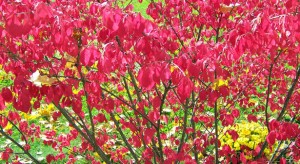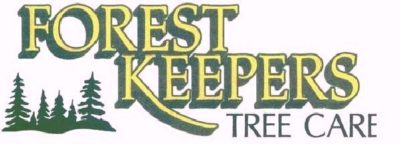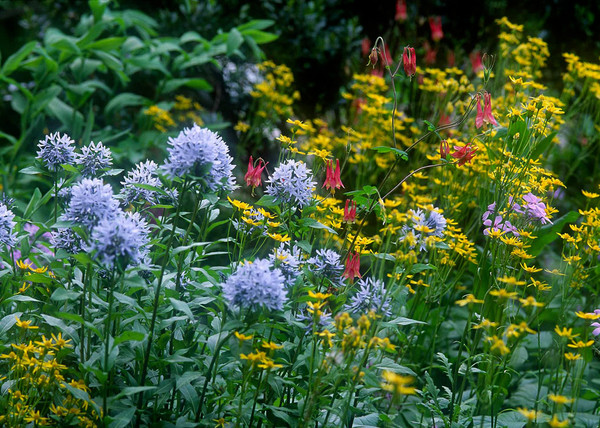The Problem With Non- Native Invasive Plants
Many gardeners and growing have, no doubt heard about non- native, invasive plant species by now. At least I hope this is so, and I hope and that we can make many others aware of this “growing” problem.

Bittersweet is a classic example of an invasive, non- native plant.Bitter sweet can easily climb into the upper canopy, covering ans destroying what ever is in it path.
Okay, so in short the problem is this: invasive plants are quite hardy and can out compete other plant species in a particular area. As the invasive plants spread and take more ground, the other, native plants are killed off and are pushed out of their niche. This becomes a larger problem since, as native trees, shrubs and plants are pushed out , locally suited insects and wildlife that have developed along side of them begin to loose the habitat and food sources that they need. Eventually this works it’s way up the local food chains and creates problems on a larger scale. Invasive plants can be brought into an area much by accident or may even have been planted right in you r yard. Not all invasive plants are “weeds”.

Euonymous alatus, Burning Bush was planted ,often, for it’s remarkable fall color. But there are many native plants that will give you this same color and less damage to the local plant communities
Some invasives have been commercially grown and sold before they were recognized for the problem that they are.Burning Bush Euonymous alatus, Norway Maple Acer platanoides, and Japanese Barberry Berberis thunbergii are just a few examples of this.
Here are some good resources for identifying Non- native, invasive species:
USDA Invasive Plant Field Guide
Invasive & Poisonous Plant Guide
The Invasive Plant Atlas of New England’s (IPANE)
Planting Native Species That Build Up Local Habitats
Diverse, healthy populations of wildlife actually help to create healthy growing conditions. Pests and diseases are less of a problem in an environment that is well established with a full spectrum of plants, insects and animals. We could go a long way in helping to build up habitats for local wildlife in our gardening by doing just a few simple things!
-Less lawn! this is a big one. I’m not saying that we need to completely eliminate turf from our landscaping, but we could certainly cut the amount of fertilizing, watering, spraying, fuel emissions, noise pollution, etc. by cutting back the amount of our prized green carpet even just a little bit. Not to mention that acres and acres of sterile, artificially green monoculture do very little towards building up bio-diversity. Incidentally, did you know that 92% of our suburban areas is lawn and 600 square miles of lawn is added in this country every year. I think we can afford a bit less than that.
-Consider the native plant community that naturally grows in your location. Look around in the fields and forest in your town. Take note of what grows where nobody has planted. You may find a nice variety of very beautiful plant choices that are going to require a lot less fussing over. At the same time you will start to get a sense of what type of plants want
to grow where you are. Nothing like being happy where you are. Further more, it only makes sense that local wildlife feeds on local plant material. The more native species that we plant the more we build the food chain.
– Remove invasive plants from your yard. With 30% of the plants in our natural areas being invasive plants, and with over 3400 species of invasive plants in this country, I know that this is a big task to think about tackling. But all the more reason for us to do the little bit that we can in each place that we plant. It doesn’t make sense to plant anything if it is just going to be swallowed up and lost in a sea of bittersweet or knotweed in a few years.
Some good Native plant resources:
Native Plants For a Cape Cod Garden has a great plant list that is growing
Native Plant List for the Cultivated Cape Cod Landscape
NATIVE PLANT LIST for Connecticut, Massachussetts, and Rhode Island
Sylvan Nursery in Westport MA is a great source for, well grown, native plant stock
And if you are on Cape Cod ( as you can tell I am) Hyannis Country Garden is another fabulous source for native plant material. Not to mention a very knowledgeable staff!






Comments
I see Scotch Broom being sold everywhere out here in SoCal and it is invading so much of our land. Because of the showy yellow flowers of this plant the nurseries and big box stores insist on carrying them. And people keep planting them like crazy. It’s frustrating education on this matter is so lacking. Scotch Broom IS pretty, but offers no food or habitat help for native wildlife. Pampas grass is another popular invader here. They may be pretty, but we may rue our choices in the not-so-distant future.
And so the story goes!
From what I understand, THe Kudzu down in the Southern States, that is killing everything else off, was introduced intentionally. Also the Gypsy Moth was introduced by an entomologist who was studying silk producing insects and accidentally let them escape . When will we learn?
It never hurst to remind gardeners to remove invasives growing in their landscapes and replace them with attractive natives!
Yep, it’s a constant battle in some areas. I have heaps of bittersweet and Wisteria ( as pretty as it is) on the back hill that is creeping up and trying, so covertly, to work it’s way into our vegetable garden. I think that the time is coming to rip it all out and re plant the hill with something a bit less obnoxious.
Great science, horticulture and post! Thanks very much!
This is right up my alley and chock full of info and resources that I can use..Thank you.. We wanted to remove a norway maple that is in front of our house, but were told that it belongs to our town and we can’t remove it. But we have removed 4 privet at least and am working on it..thank you for all this…Michelle
You know, it’s funny that you mention the Maple that the town owns because I was contemplating between a “native vs. invasive” post or a “Make sure that you don’t plant on town right of ways” post.
Pingback: Garden Bloggers You Can Grow That Day – April 4 « Whole Life Gardening
Great post! I’ve got a bunch of wisteria that’s invaded my compost pile. It’s grown all lush and green, and I can’t dig out any compost because it’s full of runners. 🙁
Pingback: Flame Willow | Landscaping - Gardening
If I were to look around my area for flowers which grow naturally in our empty places locally – I’d land up with a pretty garden of plants which take over everything; Buddleia, Rape and Valerian. I find it hard to see why people are as antagonistic as they often are to dandelions but Buddleia can pull down walls – and as for brambles and nettles . . . there are so many around it would hardly help the world if I added to them. Isn’t this part of the problem? When we create gardens, the point is often to differentiate our little patch – the place we relax – from the ordinary world beyond. We want to set off our imaginations, pretend we live somewhere more exotic than we do.
Lawns are awkward. I think in North America they are pampered more than they are in Britain – where the problem is not so much people watering their lawns (even though it may well be a problem) rather, the danger is that so many people are putting down hard surfaces there is no-where for rain water to go. It has to run into drains instead of seeping into the ground and, thus, it is lost.
Well yes, certainly there is an over abundance of certain plants that might even be “native”. I certainly am not in favor of growing boring, invasive gardens just based on a principle. Nor do I feel that the only thing to be planted are natives. But we do need to consider the overall environmental impact of the gardening choices we make. You have some real lovely native species over there in the UK : Scilla, Cowslip, Foxgloves just to name a few.
Check out the link to this publication for native plants of the UK. It’s pretty good web site
http://www.plantlife.org.uk/publications/gardening_without_harmful_invasive_plants/
Oh and yes. I agree about the Dandelion. I think that it has received an undeserved bad reputation. it is actually one of my favorite plants. Does that make me contrary? perhaps so……
Pingback: Horse Chestnut and Red Maple | Tree Care Tips